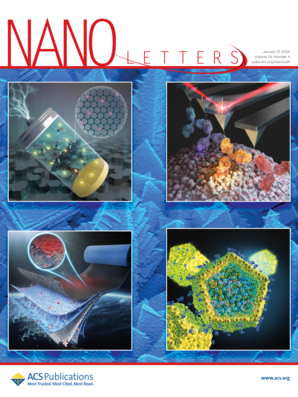Wafer-Scale Tellurium Nanotube Meshes for Optically Modulated and Mechanically Flexible Artificial Synapses.
IF 9.6
1区 材料科学
Q1 CHEMISTRY, MULTIDISCIPLINARY
引用次数: 0
Abstract
Tellurium (Te) nanotube (NT) meshes fabricated via a scalable low-temperature chemical vapor deposition (CVD) process are being explored for flexible optoelectronic synapse applications. Centimeter-scale meshes composed of highly networked single-crystalline individual Te nanorods are directly grown on polymeric substrates at a low temperature of 350 °C. The Te NT meshes exhibit p-type semiconducting behaviors accompanied by an optical bandgap of ∼0.48 eV coupled with an excellent mechanical deformability. Flexible devices incorporating these materials yield intriguing characteristics essential for optoelectronic artificial synapses, i.e., bending-invariant photoresponsiveness, optical pulse-induced potentiation, and electrical pulse-induced depression. Such features enable the simulation of various biologically inspired synaptic functionalities, including short- and long-term plasticity and paired-pulse facilitation (PPF), as well as demonstrations of Pavlovian associative learning and visual perception emulation. This work addresses key challenges in establishing scalable manufacturing for mechanically reconfigurable and functionally versatile platforms toward emerging neuromorphic applications.用于光调制和机械柔性人工突触的片级碲纳米管网格。
利用低温化学气相沉积(CVD)工艺制备碲(Te)纳米管(NT)网用于柔性光电突触的研究正在进行中。由高度网络化的单晶单个Te纳米棒组成的厘米级网格在350℃的低温下直接生长在聚合物衬底上。Te NT网具有p型半导体行为,光学带隙为0.48 eV,具有优异的机械可变形性。结合这些材料的柔性器件产生了光电人工突触必不可少的有趣特性,即弯曲不变性光响应,光脉冲诱导增强和电脉冲诱导抑制。这些特征使模拟各种生物学启发的突触功能,包括短期和长期可塑性和成对脉冲促进(PPF),以及巴甫洛夫联想学习和视觉感知模拟的演示。这项工作解决了为新兴神经形态应用建立可扩展制造机械可重构和功能通用平台的关键挑战。
本文章由计算机程序翻译,如有差异,请以英文原文为准。
求助全文
约1分钟内获得全文
求助全文
来源期刊

Nano Letters
工程技术-材料科学:综合
CiteScore
16.80
自引率
2.80%
发文量
1182
审稿时长
1.4 months
期刊介绍:
Nano Letters serves as a dynamic platform for promptly disseminating original results in fundamental, applied, and emerging research across all facets of nanoscience and nanotechnology. A pivotal criterion for inclusion within Nano Letters is the convergence of at least two different areas or disciplines, ensuring a rich interdisciplinary scope. The journal is dedicated to fostering exploration in diverse areas, including:
- Experimental and theoretical findings on physical, chemical, and biological phenomena at the nanoscale
- Synthesis, characterization, and processing of organic, inorganic, polymer, and hybrid nanomaterials through physical, chemical, and biological methodologies
- Modeling and simulation of synthetic, assembly, and interaction processes
- Realization of integrated nanostructures and nano-engineered devices exhibiting advanced performance
- Applications of nanoscale materials in living and environmental systems
Nano Letters is committed to advancing and showcasing groundbreaking research that intersects various domains, fostering innovation and collaboration in the ever-evolving field of nanoscience and nanotechnology.
 求助内容:
求助内容: 应助结果提醒方式:
应助结果提醒方式:


